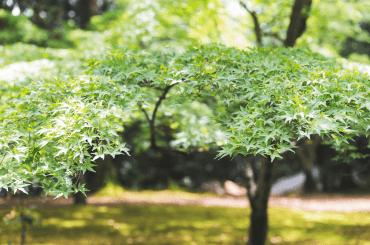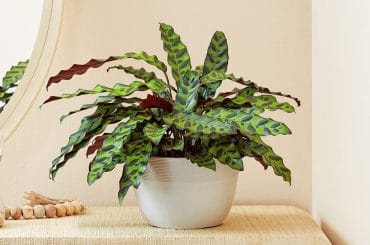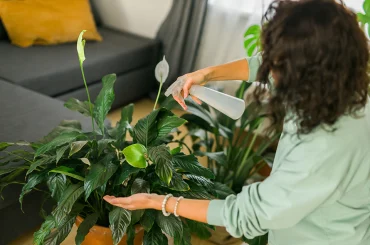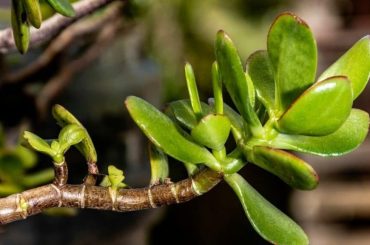Pothos N’ Joy vs Pearls and Jade
Knowing the backstory of Pothos N Joy and Pearls, as well as their characteristics can help you in making a choice. The history of this beautiful tropical indoor plant goes back to the early 1900 when it was very popular throughout the California and Florida region that has since spread throughout the United States. Their beautiful looks and easy growing abilities will make Pothos a favorite choice for beginners who desire greenery in the home.
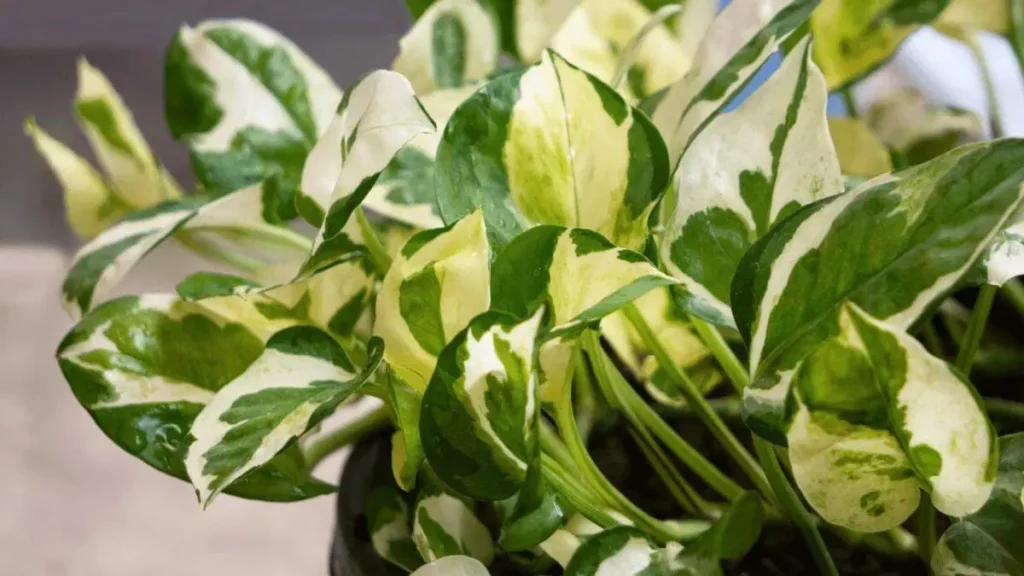
Pothos are not usually grown for flowers (or hybridized in the way we generally think of) but there have been new cultivars developed. N’ Joy and Pearls and Jade have both formed due to the Marble Queen Golden Pothos. N’ Joy was found in 2002 as a single branch mutation bearing an unusual-looking leaf design, here is Ashish Hansoti who acknowledges with his latest wildfire fern at the greenhouse adjacent to Mumbai India. In 2009, he was awarded a US patent for cloning out this mutation.
Pearls and Jade was created at the UF/IFAS Mid-Florida Research & Education Center in Apopka, FL. Marble Queen was introduced in the early 2000s as a cultivar developed when researchers subjected the plant to Cobalt-60 gamma radiation, which resulted in an induced mutation; this change was subsequently cloned over several generations until it remained fixed. The cultivar known as Pothos ‘Pearls and Jade’® (UFM12) was patented in the United States by The University of Florida in 2010.
Siblings due to having the same parent, they still differ from each other. The two main differences between N’ Joy and Pearls and Jade are their different forms of variegation, leaves shape, size compared to the length of Na details internode spaces. This subtle difference will affect which one may be the best choice for your space based on what you are looking to gain from it.
N’ Joy
According to the Pothos N’ Joy patent, its leaves are small and wide. rounded or heart-shaped, some showing a deltoid shape. Leaves: Leathery, pointed but not as sharp as the ones on Pearls and Jade. It has a gentle appearance and green patches that partially cover the midrib of this N’ Joy. The differing sizes and shapes of these green spots contribute to the complexity of how this plant comes off, with multiple shades from a darker emerald color down to much closer to chartreuse against its cream-to-white canvas.
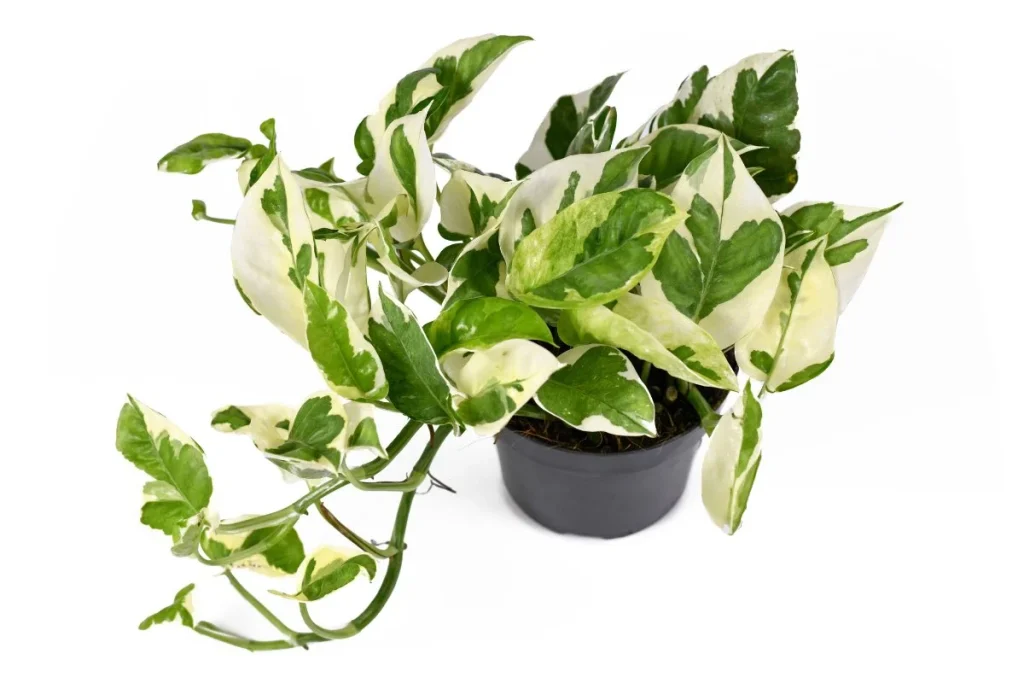
N’ Joy is known for its unique display of leaves. White or cream colors are absent from the marbled green areas as well, so you will not see any speckles of color there like in Pearls and Jade. This clarity in coloration is what sets N’ Joy apart visually, especially as the viewer can see it up close.
They have a more compact growth habit than most other Pothos, and their dark stems give the impression of strong vitality The plant also has shorter internodes. With such green spirit, it has to be a favorite among indoor gardeners with its rather small form and beautifully variegated leaves. The dappling that covers its leaves in large splashes of white or cream give it a unique (and depending on how you feel) almost bumpy and uneven look. It has this texture as opposed to the smooth surface of its parent, Marble Queen. The N’ Joy cultivar is treasured for its pronounced, crisp coloration and compact form; both are standout qualities in the pot of fibrous begonia species.
Pearls and Jade
The differences between Pothos N’ Joy and Pearls and Jade can be more nuanced, but they are big when it comes to plant geeks. Pearls and Jade has heart-shaped 2″-3″ long x1.5-2 ” wide leaves according to its patent The foliage is sharper near the tip and longer, more narrow compared to N’ Joy. Green bands are much thicker and can feature green splotches as well, mixed with white, cream or even yellow variegation. N’ Joy has more of a solid white look to it than Pearls and Jade. I personally like the contrast between green stems and white leaves from both variegated varieties with N Joy as having slightly wider bolder leaf margin highlights on (Some) specimens while another batch may be lighter looking due to thinner less bold margins which is still fine by me because growth habits are somewhat natural dark/light randomly also…

The difference again comes down to the internodes, Pearls and Jade has 1”-2” nodes a touch longer than N’ Joy_DECREF It is also a low-growing plant that grows to about 3”-5” high and spreads up to 7-8. — inches wide. Most will reach about 7 to 10 feet when grown indoors, which makes them ideal for a houseplant. Although both plants are iconic for their low level of care, the subtle differences in growth habit and appearance might offer a greater appeal to one over the other—depending on who you ask.
A quick overview…. For the super detail oriented.
Story continues below advertisement Pearls and Jade has longer, narrower heart-shaped leaves than N’ Joy.
Pearls and Jade have more white, cream or yellow color backgrounds that merge with green shades covering the entire surface.
Apple Watch with Pearl and Jade, left: Apple Cactus has a lot of internode length overall on its low-growing vine structure; higher yet Image : New Day.
The two cultivars are a common acquisition and have little to no care with plant growth expected indoors to reach between 7-10 feet.
The right characteristics really help highlight and differentiate the things that set N’ Joy apart from Pearls and Jade, giving plant enthusiasts options catered to their wants (and preferred level of care).
Pothos N’ Joy vs Pearls and Jade
Both are beautiful houseplants, but Pothos N Joy and Pearls Jade have differences between each other. So, as a one who loves these plants and to grow them I wanted to point out a few things that make them different. 7 Differences Between N’ Joy and Pearls and Jade Explained Simply.
Leaves are approximately 2″ long and1.5″ wide on the N’ Joy. They are pear shaped or heart-shaped and sometimes even triangular.
Pearls and Jade: Larger Leaves – 2″ to 3″ long, by about 1.5″ to 2 ” wide They are basically more elongated looking with the heart shape being fairly similar.
7 Differences Between N’ Joy and Pearls and Jade
Leaf Size and Shape:
N’ Joy: Leaves range around 2″ long and 1.5″ N-Endwidthenerally to Wide of Leaf Clearfix They are oval or heart shaped with a deltoid shape as well.
Pearls and Jade: The leaves are about 2″ to 3” long and some of them grow up to be just over an inch wide. They’re longer and have the same sort of heart shape.
Leaf Tip:
N’ Joy: Leaves pointed at a wide angle with stubby tip
Pearls and Jade: Points in the leaf are also sharp, but with a more acute angle and finger tip.
Leaf Coloration/Variegation:
N’ Joy: The leaves are banded with multiple greens over the midrib and often white on the margins. Without the green splashes, you can see what lovely flavors of green and cream there are.
The leaves are green with mottling and spotting of greens, yellow-greens in the within white variegation.
Leaf Texture:
N’ Joy: This plant has waxy upper leaves and leathery-bottoms with edges that naturally turn downward.
Trim cascading: Pale green white leaves, somewhat flexible and arguably papery versus N’ Joy with slight wave in the leaf.
Internodes:
N Joy: The internodes are also shorter than Pearls and Jade.
Longer internodes than in N’ Joy; Pearls and Jade
Plant Size:
It usually reaches 6-10″ in height and stays around 12″. N Joy
Pearls and Jade: Compact growing 3″ to 5″ high x 7” –8.
Vine Length:
Both will create vines that can grow up to 7′ and even longer than 10′ indoors.
With these differences, it becomes really easy for you to make out the one between Pothos N’ Joy vs Pearls and Jade in your own homes. Whether you value the brighter, more variegated N’ Joy or prefer the greener appearance of Pearls and Jade both are unquestionably unique plants that have their own charm
Care of Pothos N’ Joy and Pearls and Jade
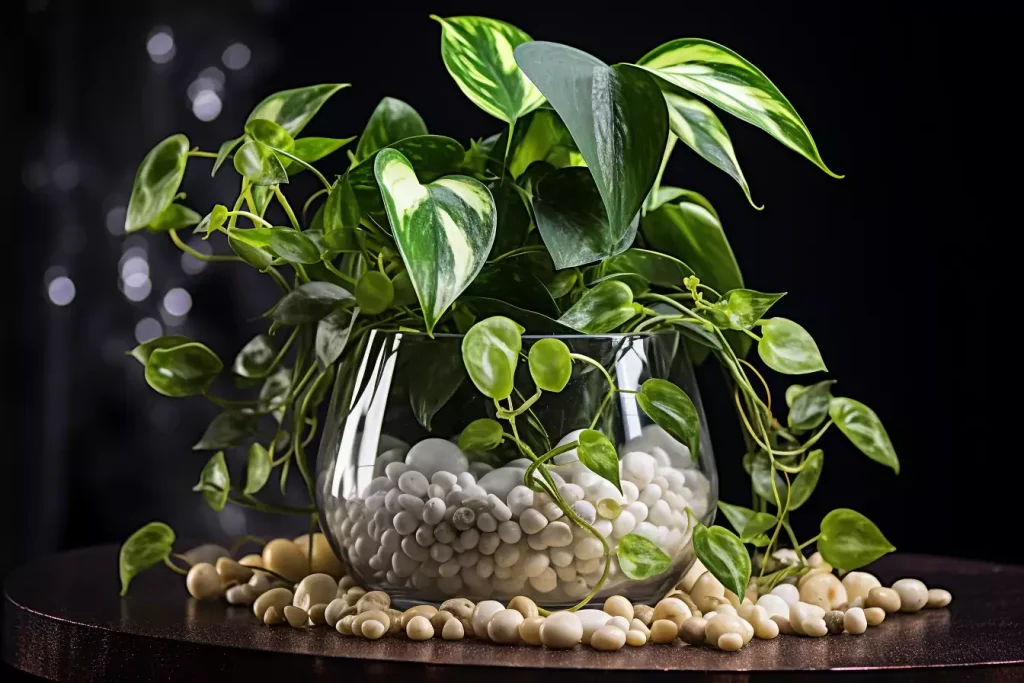
Light:
Pothos N’ Joy & Pothos Pearls and Jade both do well in bright indirect light. Their foliage can become scorched in direct sunlight. Because Pearls and Jade have more chlorophyll in the greens let it grow, that makes it better for low light areas. N’ Joy, on the other hand, possesses more white surfaces and needs to be provided with stronger indirect light to accomplish its chlorophyll. Here, N’ Joy won’t get enough light; it may continue altogether green. If outdoors, put both in bright indirect light or shade but not hot afternoon sun.
Temperature:
Both will do fine in a range of average temperatures from 65-75 degrees F but can touch 90 outdoors and dip to the high 60s, though you should keep them at no less than about low-mid ’50s. If it is cool weather, they need to be placed in direct sunlight with the temperature dropping below 40 or 45 degrees keep them indoors.
- Humidity:
In their native tropical rainforest environment, these houseplants thrive in high humidity as well. They are good for humidity levels of 30%–40%, but higher is best and critical in the winter. Increase the humidity by placing them in a humid bathroom/kitchen using a pebble tray or even with an actual humidifier.
Soil:
The soil they correct should be fertile, well-drained and loose. A good commercially available potting mix with either perlite, orchid bark, coco coir or peat moss is critical for proper drainage and airflow. When it comes to the smaller N’ Joy, a 4″ pot with less soil may be needed because this grows slower than Pearls and Jade.
Water:
Proper watering is crucial. The key is to water only when the soil 1 or 2 inches down already dry Water the soil and allow excess water to run out through the drainage holes. Allow to dry out between watering, and do not sit in water causing root rot. It has a slower growth rate and not containing as much green will need to be watered less often than Pearls and Jade.
Fertilizer:
Fertilize Pearls and Jade with a balanced N-P-K indoor fertilizer every month during the growing season. But N’ Joy requires a fertilizer with lower nitrogen so that the plant does not produce too many green leaves, and should be fertilized two to three times from spring through early fall.
- Pests:
Both plants suffer from aphids, spider mites, mealybugs and scale pests. Use insecticidal soap or Neem oil for the treatment. Wash scale insects away with a little stream of water and use some rubbing alcohol to wipe your plants clean.
Pruning:
Both make great Pothos for sale, indoors where they can grow 7 to 10 feet long. Prune them to just above a leaf node with clean, sharp scissors or shears. This also helps keep them in shape and promotes good growth.
FAQs
What is the difference between pothos Pearls and jade and pothos n joy?
Marianne B. | Comparing Pearls & Jade Pothos to N’joy Pothos…
Pearls and jade – them bad boys make u think they’re a snow queen pothos looking plant but their whitey bits are green splashes 💚
What is Pearl and Jade pothos?
Pothos — Pearls & Jade | Plant Care | LiveTrends Design Group
Variegated cultivar from Florida of Epipremnum aureum ‘Pearls and Jade’ The waxy green leaves are coated with streaks and blotches of white, cream, and light green resulting in a flashy foliage plant.
Why are my pearls and jade pothos dying?
Yellow leaves generally occur due to overwatering or lack of light, but can also be the result of under watering or overexposure to light (confusing we know).
Why is my pearls and jade pothos drooping?
The Pothos likes to have its soil kept constantly damp. Ensure your plant is not over or underwatered. Water on a regular schedule–when the top 2”-3” of soil are dry. Limp, drooping leaves, and often browned areas If you completely dried out the soil of course.


